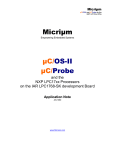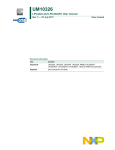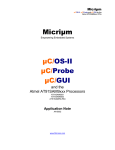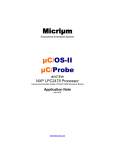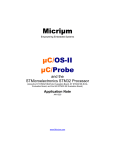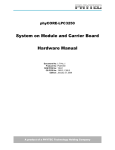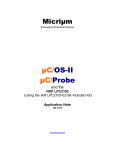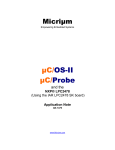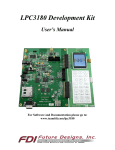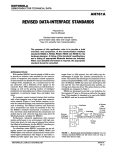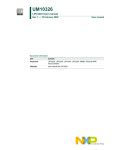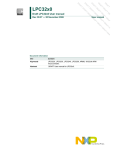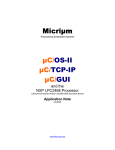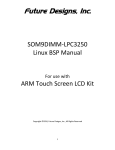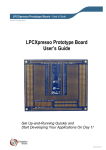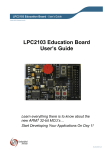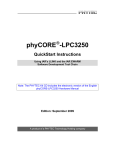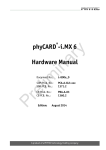Download Asynchronous Serial Communication
Transcript
Micriµm
Empowering Embedded Systems
μC/OS-II
μC/Probe
and the
NXP LPC3250/LPC3180 Processors
(Using the phyCORE®-ARM9/LPC3250/LPC3180 Rapid Development Kit)
Application Note
AN-1250
www.Micrium.com
Micriµm
µC/OS-II and µC/Probe for the NXP LPC32x0 and LPC318x CPUs
About Micriµm
Micriµm provides high-quality embedded software components in the industry by way of engineer-friendly
source code, unsurpassed documentation, and customer support. The company‟s world-renowned realtime operating system, the Micriµm µC/OS-II, features the highest-quality source code available for
today's embedded market. Micriµm delivers to the embedded marketplace a full portfolio of embedded
software components that complement µC/OS-II. A TCP/IP stack, USB stack, CAN stack, File System
(FS), Graphical User Interface (GUI), as well as many other high quality embedded components.
Micriµm‟s products consistently shorten time-to-market throughout all product development cycles. For
additional information on Micriµm, please visit www.micrium.com.
About µC/OS-II
Thank you for your interest in µC/OS-II. µC/OS-II is a preemptive, real-time, multitasking kernel.
µC/OS-II has been ported to over 45 different CPU architectures and now, has been ported to the Phytec
phyCORE®-ARM9/LPC3250 and phyCORE®-ARM9/LPC3180 Rapid Development Kit (RDK) evaluation
boards which include the ARM-based NXP LPC3250 and LPC3180 respectively processors.
µC/OS-II is small yet provides all the services you would expect from an RTOS: task management, time
and timer management, semaphore and mutex, message mailboxes and queues, event flags a much
more.
You will find that µC/OS-II delivers on all your expectations and you will be pleased by its ease of use.
Licensing
µC/OS-II is provided in source form for FREE evaluation, for educational use or for peaceful research. If
you plan on using µC/OS-II in a commercial product you need to contact Micriµm to properly license its
use in your product. We provide ALL the source code with this application note for your convenience and
to help you experience µC/OS-II. The fact that the source is provided DOES NOT mean that you can
use it without paying a licensing fee. Please help us continue to provide the Embedded community with
the finest software available. Your honesty is greatly appreciated.
2
Micriµm
µC/OS-II and µC/Probe for the NXP LPC32x0 and LPC318x CPUs
About µC/Probe Demo Version
μC/Probe is a Windows application that allows a user to display and change the value (at run-time) of
virtually any variable or memory location on a connected embedded target. The user simply populates
μC/Probe‟s graphical environment with gauges, tables, graphs, and other components, and associates
each of these with a variable or memory location. Once the application is loaded onto the target, the user
can begin μC/Probe‟s data collection, which will update the screen with variable values fetched from the
target.
μC/Probe retrieves the values of global variables from a connected embedded target and displays the
values in an engineer-friendly format. The supported data-types are: booleans, integers, floats and ASCII
strings.
μC/Probe can have any number of „data screens‟ where these variables are displayed. This allows to
logically grouping different „views‟ into a product.
This μC/Probe demo version can only retrieve information from RS-232C or J-LINK interfaces and is
limited up to 15 symbols.
The demo version of μC/Probe is available on the Micriµm website:
http://www.micrium.com/products/probe/probe.html
About µC/Probe Full Version
The full version of μC/Probe allows you to use a TCP/IP is a Windows application that allows a user to
display and change the value (at run-time) of virtually any variable or memory location on a connected
embedded target. The user simply populates μC/Probe‟s graphical environment with gauges, tables,
graphs, and other components, and associates each of these with a variable or memory location. Once
the application is loaded onto the target, the user can begin μC/Probe‟s data collection, which will update
the screen with variable values fetched from the target.
3
Micriµm
µC/OS-II and µC/Probe for the NXP LPC32x0 and LPC318x CPUs
Manual Versions
If you find any errors in this document, please inform us and we will make the appropriate corrections for
future releases.
Version
Date
By
Description
V.1.00
2009/03/31
FT
Updated for Phytec LPC3250 rev 1305.3 board
V.1.00
2008/08/20
FT
Initial version.
Software Versions
This document may or may not have been downloaded as part of an executable file, Micrium-NXP-uCOSII–LPC3250-Phytec.exe, containing the code and projects described here. If so, then the versions of the
Micriµm software modules in the table below would be included. In either case, the software port
described in this document uses the module versions in the table below
Module
Version
μC/OS-II
V2.88
μC/OS-Probe
V2.30
Comment
4
Micriµm
µC/OS-II and µC/Probe for the NXP LPC32x0 and LPC318x CPUs
Document Conventions
Numbers and Number Bases
Hexadecimal numbers are preceded by the “0x” prefix and displayed in a monospaced font.
Example: 0xFF886633.
Binary numbers are followed by the suffix “b”; for longer numbers, groups of four digits are
separated with a space. These are also displayed in a monospaced font. Example: 0101 1010
0011 1100b.
Other numbers in the document are decimal.
prevailing where the number is used.
These are displayed in the proportional font
Typographical Conventions
Hexadecimal and binary numbers are displayed in a monospaced font.
Code excerpts, variable names, and function names are displayed in a monospaced font.
Functions names are always followed by empty parentheses (e.g., OS_Start()). Array names
are always followed by empty square brackets (e.g., BSP_Vector_Array[]).
File and directory names are always displayed in an italicized serif font.
/Micrium/Sofware/uCOS-II/Source/.
Example:
A bold style may be layered on any of the preceding conventions—or in ordinary text—to more
strongly emphasize a particular detail.
Any other text is displayed in a sans-serif font.
5
Micriµm
µC/OS-II and µC/Probe for the NXP LPC32x0 and LPC318x CPUs
Table of Contents
1.
Installing the Micirum Software
7
2.
Using the Micirum IAR Example Project
2.01.01 IAR µC/OS-II Kernel Awareness.
2.01.02 IAR Project Configurations
2.02
Running the Example Applications
8
8
9
10
3.
Directories and Files
13
4.
Application Code
17
4.01
4.02
app.c
os_cfg.h
17
19
5.
5.01
5.02
Board Support Package (BSP)
BSP, bsp_xxx.c and bsp_xxx.h files
Board Support Package Configuration
21
21
23
6.
μC/Probe
24
Licensing
27
References
27
Contacts
27
6
Micriµm
µC/OS-II and µC/Probe for the NXP LPC32x0 and LPC318x CPUs
1.
Installing the Micirum Software
The source code for µC/OS-II is provided in source form along with IAR EW project files that allows you
to run µC/OS-II on the Phytec LPC3250 and LPC3180 development boards. To install the software,
simply run the self-extracting executable. Micrium-NXP-uCOS-II LPC3xxx-Phytec.exe.
You will be prompted to accept the simple terms of the licensing agreement. If you answer „Yes‟, the
software will be installed on your PC under the \Micrium directory from the root as shown in Figure 1-1
\Micrium
\AppNotes
AN-1018
\AN1xxx-RTOS
Licensing agreements
\AN1014-uCOS-II-ARM
(If µC/OS-II is used
\AN1250-UCOS-II-NXP-LPC3xxx
AN-1250
commercially)
\Licensing
Contact
\Software
www.Micrium.com
\EvalBoards
Phytec LPC3250 Board
\NXP
for pricing
Support Package
\LPC3250-Phytec
\IAR
\BSP
Phytec LPC3180 Board
\OS-v2
Support Package
IAR Example Project for
\OS-Probe
the Phytec LPC3250
\LPC3180-Phytec
Development Board
\IAR
IAR Example Project for
\BSP
the Phytec LPC3180
\OS-v2
Development Board
\OS-Probe
\uC-CPU
\ARM
µC/LIB
\IAR
\uC-LIB
The
Run-Time
µC/OS-II
\uCOS-II
LibraryKernel
The Real Time
\Doc
Kernel
ARM7 / ARM9
\Ports
µC/OS-II port
\ARM
\Generic
µC/OS-II
\IAR
documentation
\Source
µC/OS-II processor
\uC-Probe
independent source
\Target
µC/Probe
code
\Communication
Real-Time Monitor
\DCC
Target
\Generic
Communication
\OS
\RS-232
RS-232
\Ports
Communication
\NXP
\LPC3xxx
\Source
µC/Probe
\Source
LPC32x0/LPC318x Port
\Workspace
\Plugins
\uCOS-II
Figure 1-1. Directory Structure
7
Micriµm
µC/OS-II and µC/Probe for the NXP LPC32x0 and LPC318x CPUs
2.
Using the Micirum IAR Example Project
To view the example project, start an instance of IAR Embedded Workbench, and open:
For the Phytec LPC3250 evaluation board , LPC3250-Phytec-OS-Probe.ewp, located in
/Micrium/Software/EvalBoards/NXP/LPC3250-Phytec/IAR/OS-Probe
For the Phytec LPC3180 evaluation board , LPC3180-Phytec-OS-Probe.ewp, located in
/Micrium/Software/EvalBoards/NXP/LPC3250-Phytec/IAR/OS-Probe
To do this, use the Add Existing Project... menu command under the Project menu:
Figure 2-1. IAR EW. Opening an existing project
IAR EWARM Versions
Be certain to open the proper project for your version of EWARM. The Phytec
LPC3250/PC3280 examples projects were created using EWARM ver. 5.3
2.01.01 IAR µC/OS-II Kernel Awareness.
The µC/OS-II Kernel Awareness plug-in will allow you to examine information about system objects while
using the C-Spy debugger. To gain access to this feature, enable the plug-in by right-clicking on the
project name in the work space browser and choosing Options… Then, select the “Debugger” entry in the
list box, and the “Plug-in” tab pane. Find the µC/OS-II entry in the list and, finally, select the check box
beside the entry.
8
Micriµm
µC/OS-II and µC/Probe for the NXP LPC32x0 and LPC318x CPUs
Figure 2-2. Enabling the μC/OS-II Kernel Awareness Plug-In
2.01.02 IAR Project Configurations
The IAR project configurations allow you to compile, link and load the software in different ways to the
target. The following configurations are available in the IAR projects as shown in figure 2-3.
IRAM: This project option is configured to load the code into the processor‟s internal RAM (IRAM).
XRAM: This project option is configured to load the code into the board‟s external SDRAM
(XRAM).
IRAM boot from NAND: This option is configured to flash the code into the board‟s external NAND
memory and load it to the IRAM using the example bootloader provided by IAR.
XRAM boot from NAND: This option is configured to flash the code into the board‟s external
NAND memory and load it to the XRAM using the example bootloader provided by IAR.
Note (1): In order to used the “IRAM boot from NAND” configuration in the Phytec LPC3250
project, you must copy the file
FlashPhytecLPC3250_NAND_IRAMload.xml from the example project folder
/Micrium/Software/EvalBoards/NXP/LPC3250-Phytec/IAR/OS-Probe
to the IAR EW installation folder
\Program Files\IAR Systems\Embedded Workbench 5.4/arm/config/flashloader/NXP
Note (2): In order to used the “IRAM boot from NAND” configuration in the Phytec LPC3180
project, you must copy the file
FlashPhytecLPC3180_NAND_IRAMload.xml from the example project folder
/Micrium/Software/EvalBoards/NXP/LPC3180-Phytec/IAR/OS-Probe
to the IAR EW installation folder
\Program Files\IAR Systems\Embedded Workbench 5.4/arm/config/flashloader/NXP
9
Micriµm
µC/OS-II and µC/Probe for the NXP LPC32x0 and LPC318x CPUs
Phytec LPC3250 Only.
Note (3): Be certain to select the proper configuration for you revision of the board.
IRAM boot from NAND (32M)
XRAM boot from NAND (32 M)
Only can be used with revision 1304.0 of the Module board.
IRAM boot from NAND (64 M)
XRAM boot from NAND (64 M)
Only can be used with revision 1304.1 of the Module board.
Phytec LPC31250 Module
for
Board UART5
ver. 1304.0
System State
Figure 2-3. IAR project configurations
2.02
Running the Example Applications
The example project includes a basic demonstration of μC/OS-II and μC/Probe. The evaluation board
components are labeled in the figures 2-3 and 2-4:
The example application is the same for the both Phytec boards.
To communicate with the board through RS-232, connect a serial cable between the evaluation board
serial port “BTM=UART5” and your PC and open a HyperTerminal or any Terminal program window.
Configure the RS-232 interface with the following settings:
10
Micriµm
µC/OS-II and µC/Probe for the NXP LPC32x0 and LPC318x CPUs
Bits per Second:
Data bits:
Parity:
Stops bits:
Flow Control:
115200
8
None
1
None
Once the program is loaded onto the target, the LEDs will start blinking.
JTAG
connector
UART2/3 for
µC/OS-Probe
USB
Host
SD/MMC
USB
Device
USB
OTG
Push
Buttons
LEDs
Figure 2-3. Phycore-LPC3180 Rapid Development Kit (RDK)
UART2/3 for
µC/OS-Probe
UART5 for
System State
DC Adaptor
USB
Host
USB
Device
USB
OTG
Ethernet
LCD Display
Module
SDIO
SD/MMC
JTAG
connector
Push
Buttons
LEDs
11
Single board
computer
Micriµm
µC/OS-II and µC/Probe for the NXP LPC32x0 and LPC318x CPUs
Figure 2-4. Phycore-LPC3250 Rapid Development Kit (RDK)
The lower RS-232 port labeled as “BTM=UART5” (at 115200 baud) is used to output text.
The upper RS-232 port labeled as “TOP=UART 3/2” is used for µC/Probe (at 115200 baud), which
allows you to view (in real-time) the value of static / global variables in the target system.
The text shown in Figure 2-5 will be displayed in the HyperTerminal Window.
System State
General Info
OS ver. & Ticks per Sec
CPU Usage & CPU Speed
#Ticks & #ContextSwitches
Figure 2-5. Application output (LPC3250)
The push buttons can be used to change the output to a new item.
If you use the “IRAM/XRAM boot from NAND configuration” you might have to stop the debugger first and
power cycle the board.
12
Micriµm
µC/OS-II and µC/Probe for the NXP LPC32x0 and LPC318x CPUs
3.
Directories and Files
Application Notes
\Micrium\AppNotes\AN1xxx-RTOS\AN1014-uCOS-II-ARM
This directory contains AN-1014.pdf, the application note describing the ARM port for μC/OS-II,
and AN-1014-PPT.pdf, a supplement to AN-1014.pdf.
\Micrium\AppNotes\AN1xxx-RTOS\AN1250--uCOS-II-NXP-LPC3xxx
This directory contains this application note, AN-1250.pdf.
Licensing Information
\Micrium\Licensing
Licensing agreements are located in this directory. Any source code accompanying this appnote
is provided for evaluation purposes only. If you choose to use μC/OS-II in a commercial product,
you must contact Micriμm regarding the necessary licensing.
μC/OS-II Files
\Micrium\Software\uCOS-II\Doc
This directory contains documentation for μC/OS-II.
\Micrium\Software\uCOS-II\Ports\ARM\Generic\IAR
This directory contains the standard processor-specific files for the generic μC/OS-II ARM port
assuming the IAR toolchain and the ARM/Keil “RealView Microprocessor Development Kit”
toolchain.
These files could easily be modified to work with other toolchains (i.e.,
compiler/assembler/linker/locator/debugger); however, the modified files should be placed into a
different directory. The following files are in this directory:
os_cpu.h
os_cpu_a.asm
os_cpu_c.c
os_dcc.c
os_dbg.c
With this port, μC/OS-II can be used in either ARM or Thumb mode. Thumb mode, which
drastically reduces the size of the code, was used in this example, but compiler settings may be
switched (as discussed in Section 2.30) to generate ARM-mode code without needing to change
either the port or the application code. The ARM/Thumb port is described in application note AN1014 which is available from the Micrium web site.
\Micrium\Software\uCOS-II\Source
This directory contains the processor-independent source code for μC/OS-II.
13
Micriµm
µC/OS-II and µC/Probe for the NXP LPC32x0 and LPC318x CPUs
μC/Probe Files
\Micrium\Software\uC-Probe\Communication\Generic\
This directory contains the μC/Probe generic communication module, the target-side code
responsible for responding to requests from the μC/Probe Windows application (including
requests over RS-232).
\Micrium\Software\uC-Probe\Communication\Generic\Source
This directory contains probe_com.c and probe_com.h, the source code for the generic
communication module.
\Micrium\Software\uC-Probe\Communication\Generic\OS\uCOS-II
This directory contains probe_com_os.c, which is the μC/OS-II port for the μC/Probe generic
communication module.
\Micrium\Software\uC-Probe\Communication\Generic\Source\RS-232
This directory contains the RS-232 specific code for μC/Probe generic communication module,
the target-side code responsible for responding to requests from the μC/Probe Windows
application over RS-232
\Micrium\Software\uC-Probe\Communication\Generic\Source\RS-232\Source
This directory contains probe_rs232.c and probe_rs232.h, the source code for the generic
communication module RS-232 code.
\Micrium\Software\uC-Probe\Communication\Generic\Source\RS-232\Ports\NXP\LPC3xxx
This directory contains probe_rs232c.c and probe_rs232c.h, the NXP LPC3xxx port for the RS-232
communications.
\Micrium\Software\uC-Probe\Communication\Generic\Source\RS-232\OS\uCOS-II
This directory contains probe_rs232_os.c, which is the μC/OS-II port for the μC/Probe RS-232
communication module.
μC/CPU Files
\Micrium\Software\uC-CPU
This directory contains cpu_def.h, which declares #define constants for CPU alignment,
endianness, and other generic CPU properties.
\Micrium\Software\uC-CPU\ARM\IAR
This directory contains cpu.h and cpu_a.s. cpu.h defines the Micriμm portable data types for 8-,
16-, and 32-bit signed and unsigned integers (such as CPU_INT16U, a 16-bit unsigned integer).
These allow code to be independent of processor and compiler word size definitions. cpu_a.s
contains generic assembly code for ARM7 and ARM9 processors which is used to enable and
disable interrupts within the operating system.
This code is called from C with
OS_ENTER_CRITICAL() and OS_EXIT_CRITICAL().
μC/LIB Files
\Micrium\Software\uC-LIB
This directory contains lib_def.h, which provides #defines for useful constants (like DEF_TRUE
and DEF_DISABLED) and macros.
14
Micriµm
µC/OS-II and µC/Probe for the NXP LPC32x0 and LPC318x CPUs
\Micrium\Software\uC-LIB\Doc
This directory contains the documentation for μC/LIB.
Application Code
\Micrium\Software\EvalBoards\NXP\LPC3180-Phytec\IAR\OS-Probe
\Micrium\Software\EvalBoards\NXP\LPC3250-Phytec\IAR\OS-Probe
This directory contains the source code the example application:
app.c contains the test code for the example application including calls to the functions
that start multitasking within μC/OS-II, register tasks with the kernel, and update the user
interface (the LEDs and the push buttons).
app_cfg.h is a configuration file specifying stack sizes and priorities for all user tasks and
#defines for important global application constants.
app_probe.c/h contain code to initialize μC/Probe,
app_hooks.c/h contain code for the μC/OS-II application hooks.
includes.h is the master include file used by the application.
os_cfg.h is the μC/OS-II configuration file.
probe_com_cfg.h is the μC/Probe configuration file.
LPC3250-Phytec-OS-Probe.* are the IAR Embedded Workbench project files for the
Phytec LPC3250 Board.
LPC3180-Phytec-OS-Probe.* are the IAR Embedded Workbench project files for the
Phytec LPC3180 board.
\Micrium\Software\EvalBoards\NXP\LPC3180-Phytec\IAR\BSP
\Micrium\Software\EvalBoards\NXP\LPC3250-Phytec\IAR\BSP
This directory contains the Board Support Package for the PHYCore-LPC3250 RDK:
bsp.c /bsp.h contain generic BSP functions which initialize critical processor functions (e.g.,
the PLL) and provide support for peripherals such as the push button and LEDs.
bsp_a.s contains the low level functions (written in assembly language ) for the PHYCoreLPC3250 RDK
bsp_int.c/bsp_int.h contains functions related to the interrupt controller
bsp_lcd.c/bsp_lcd.h contains functions related to the LCD controller (LPC3250 only).
bsp_pwr_ctrl.c/bsp_pwr_ctrl.h contains functions related to Power & clock controller .
bsp_touch_scr.c/bsp_touch_scr.h contains functions related to the touch screen controller
LPC3250 (only)
15
Micriµm
µC/OS-II and µC/Probe for the NXP LPC32x0 and LPC318x CPUs
bsp_ser.c/bsp_ser.h contains functions related to UARTs.
cstartup.s performs critical processor initialization (such as the initialization of task stacks),
readying the platform to enter main().
LPC3250_xRAM.icf/LPC3180_xRAM.icf is the IAR linker files which contain information
about the placement of data and code segments in the processor‟s memory map, where
„x‟ can be „I‟ for internal RAM (IRAM) or „X‟ for external RAM (XRAM).
LPC3250_xRAM.mac/LPC3180_xRAM.mac contains instructions that are executed prior to
loading code onto the processor, where „x‟ can be „I‟ for internal RAM (IRAM) or „X‟ for
external RAM (XRAM)
Micrium\Software\EvalBoards\NXP\LPC3180-Phytec\IAR\BSP\OS-v2
Micrium\Software\EvalBoards\NXP\LPC3250-Phytec\IAR\BSP\OS-v2
bsp_os.c/h encapsulates some of the μC/OS-II kernel services. Implements the timer
initialization needed for the ticker interrupt needed in μC/OS-II .
16
Micriµm
µC/OS-II and µC/Probe for the NXP LPC32x0 and LPC318x CPUs
4.
Application Code
The example application described in this appnote, AN-1250, is a simple demonstration of μC/OS-II and
μC/OS-Probe for the NXP LPC3250 processor on the PHYCore-LPC3250 RDK and the NXP LPC3180
LPC3250 processor on the PHYCore-LPC3180 RDK.
4.01
app.c
Four functions of interest are located in app.c:
1. main() is the entry point for the application, as it is with most C programs. This function
initializes the operating system, creates the primary application task, App_TaskStart(), begins
multitasking, and exits.
2. App_TaskStart(), after creating the application events and tasks, enters an infinite loop in
which it blinks the LEDs.
3. App_TaskKbd()polls the user inputs—the push buttons—and, if new input is detected, places a
message in a queue for App_TaskSer().
4. App_TaskUserIF(),Outputs the state of the system based on the display state passed to it by
App_TaskKbd().
int main (void)
{
#if (OS_TASK_NAME_EN > 0)
CPU_INT08U err;
#endif
/* Note 1 */
BSP_IntDisAll();
/* Note 2 */
OSInit();
/* Note 3 */
OSTaskCreateExt((void (*)(void *)) App_TaskStart,
/* Note 4 */
(void
*) 0,
(OS_STK
*)&AppTaskStartStk[APP_CFG_TASK_START_STK_SIZE - 1],
(INT8U
) APP_CFG_TASK_START_PRIO,
(INT16U
) APP_CFG_TASK_START_PRIO,
(OS_STK
*)&AppTaskStartStk[0],
(INT32U
) APP_CFG_TASK_START_STK_SIZE,
(void
*) 0,
(INT8U
)(OS_TASK_OPT_STK_CHK | OS_TASK_OPT_STK_CLR));
#if (OS_TASK_NAME_EN > 0)
/* Note 5 */
OSTaskNameSet(APP_CFG_TASK_START_PRIO, (CPU_INT08U *)"Startup", &err);
#endif
OSStart();
/* Note 6 */
}
Listing 4-1, main()
17
Micriµm
µC/OS-II and µC/Probe for the NXP LPC32x0 and LPC318x CPUs
Listing 4-1, Note 1: As with most C applications, the code starts in main().
Listing 4-1, Note 2: All interrupts are disabled to make sure the application does not get interrupted until it
is fully initialized.
Listing 4-1, Note 3: OSInit() must be called before creating a task or any other kernel object, as must
be done with all μC/OS-II applications.
Listing 4-1, Note 4: At least one task must be created (in this case, using OSTaskCreateExt() to
obtain additional information about the task). In addition, μC/OS-II creates either one or two
internal tasks in OSInit(). μC/OS-II always creates an idle task, OS_TaskIdle(), and will
create a statistic task, OS_TaskStat() if you set OS_TASK_STAT_EN to 1 in os_cfg.h.
Listing 4-1, Note 5: You can name μC/OS-II tasks (and other kernel objects) and display task names at
run-time or with a debugger. In this case, the App_TaskStart() is given the name “Start Task”.
Because C-Spy can work with the Kernel Awareness Plug-In available from Micriμm, task names
can be displayed during debugging.
Listing 4-1, Note 6: Finally multitasking under μC/OS-II is started by calling OSSTart(). μC/OS-II will
then begin executing App_TaskStart() since that is the highest-priority task created (both
OS_TaskStat() and OS_TaskIdle() having lower priorities).
static void App_TaskStart (void *p_arg)
{
(void)p_arg;
BSP_Init();
/* Note 1 */
OS_CPU_InitExceptVect();
/* Note 2 */
BSP_OS_TmrTickInit(OS_TICKS_PER_SEC);
/* Note 3 */
#if OS_TASK_STAT_EN > 0
OSStatInit();
#endif
/* Note 4 */
BSP_Ser_Init(115200);
APP_TRACE_INFO(("\n\n\r"));
/* Note 5 */
#if (APP_CFG_PROBE_COM_EN
== DEF_ENABLED) || \
(APP_CFG_PROBE_OS_PLUGIN_EN == DEF_ENABLED)
App_ProbeInit();
#endif
/* Note 6 */
BSP_LED_Off(0);
APP_TRACE_INFO(("Creating Application Events ... \n\r"));
App_EventCreate();
/* Note 7 */
APP_TRACE_INFO(("Creating Application Tasks ... \n\r"));
App_TaskCreate();
while (DEF_TRUE) {
BSP_LED_Toggle(0);
OSTimeDlyHMSM(0, 0, 0, 250);
BSP_LED_Toggle(0);
OSTimeDlyHMSM(0, 0, 0, 250);
}
/* Note 8 */
}
Listing 4-2, App_TaskStart ()
18
Micriµm
µC/OS-II and µC/Probe for the NXP LPC32x0 and LPC318x CPUs
Listing 4-2, Note 1: BSP_Init() initializes the Board Support Package—the I/Os, LEDs, etc. See
Section 5 for details.
Listing 4-2, Note 2: OS_CPU_InitExceptVect() Initializes the CPU interrupt vectors in RAM
Listing 4-2, Note 3: BSP_OS_TmrTickInit() Initializes the tick interrupt
Listing 4-2, Note 4: OSStatInit() initializes μC/OS-II‟s statistic task. This only occurs if you enable
the statistic task by setting OS_TASK_STAT_EN to 1 in os_cfg.h. The statistic task measures
overall CPU usage (expressed as a percentage) and performs stack checking for all the tasks
that have been created with OSTaskCreateExt() with the stack checking option set.
Listing 4-2, Note 5: BSP_Ser_Init() Initializes the RS-232 communication port at 115200.
Listing 4-2, Note 6: If µC/OS-Probe is enabled, then the module‟s initialization procedure
App_ProbeInit() is called. App_ProbeInit()calls OSProbe_Init() which initializes the
µC/Probe plug-in for µC/OS-II, which maintains CPU usage statistics for each task,
ProbeCom_Init() that initializes the µC/Probe generic communication module and
ProbeRS232_Init() that initializes the RS-232 communication module. After these have been
initialized, the µC/Probe Windows program will be able to download data from the processor.
For more information, see Section 6.
Listing 4-2, Note 7: App_EventCreate()Creates all the application uC/OS-II events and
App_TaskCreate()creates all the application tasks.
Listing 4-2, Note 8: Any task managed by µC/OS-II must either enter an infinite loop „waiting‟ for some
event to occur or terminate itself. This task enters an infinite loop in which it toggles the LEDs .
4.02
os_cfg.h
The file os_cfg.h is used to configure µC/OS-II and defines the maximum number of tasks that your
application can have, which services will be enabled (semaphores, mailboxes, queues, etc.), the size of
the idle and statistic task and more. In all, there are about 60 or so #define that you can set in this file.
Each entry is commented and additional information about the purpose of each #define can be found in
Jean Labrosse‟s book, µC/OS-II, The Real-Time Kernel, 2nd Edition. os_cfg.h assumes you have
µC/OS-II V2.83 or higher but also works with previous versions of µC/OS-II.
Task sizes for the Idle (OS_TASK_IDLE_STK_SIZE), statistics OS_TASK_STAT_STK_SIZE) and
timer (OS_TASK_TMR_STK_SIZE) task are set to 128 OS_STK elements (each is 4 bytes) and
thus each task stack is 512 bytes. If you add code to the examples make sure you account for
additional stack usage.
OS_DEBUG_EN is set to 1 to provide valuable information about µC/OS-II objects to IAR‟s C-Spy
through the Kernel Awareness plug-in. Setting OS_DEBUG_EN to 0 should some code space
(though it will not save much).
OS_LOWEST_PRIO is set to 63, allowing up to 64 total tasks.
OS_MAX_TASKS determines the number of “application” tasks and is currently set to 20 allowing
13 more tasks to be added to the example code.
19
Micriµm
µC/OS-II and µC/Probe for the NXP LPC32x0 and LPC318x CPUs
OS_TICKS_PER_SEC is set to 1000 Hz. This value can be changed as needed and the proper
tick rate will be adjusted when the BSP_OS_TmrTickInit() is called. if you change this value.
You would typically set the tick rate between 10 and 1000 Hz. The higher the tick rate, the more
overhead µC/OS-II will impose on the application. However, you will have better tick granularity
with a higher tick rate.
20
Micriµm
µC/OS-II and µC/Probe for the NXP LPC32x0 and LPC318x CPUs
5.
Board Support Package (BSP)
The Board Support Package (BSP) provides functions to encapsulate common I/O access functions and
make porting your application code easier. Essentially, these files are the interface between the
application and the PHYCore-LPC3250/LPC3180 RDK.
5.01
BSP, bsp_xxx.c and bsp_xxx.h files
Figure 5-1 and 5-2 shows the relationship between the BSP‟s files and the most important components on
the development boards (not all functions are listed only the most relevants).
Interrupt Controller
bsp_int.c/h
Push Buttons
bsp.c/h
BSP_PB_GetStatus()
BSP_IntDis()
BSP_IntDisAll()
BSP_IntEn()
BSP_IntInit()
BSP_IntVectSet()
BSP_IntSched()
Serial Interface
bsp_ser.c/h
BSP_Ser_Init()
BSP_Ser_Printf()
BSP_Ser_RdByte()
BSP_Ser_RdStr()
BSP_Ser_WrByte()
BSP_Ser_WrStr()
Power & Clock Controller
bsp_pwr_ctrl.c/h
BSP_PwrCtrl_Init()
BSP_PwrCtrl_CPU_ModeSet()
BSP_PwrCtrl_CPU_ModeGet()
LEDs
bsp.c/h
BSP_PwrCtrl_HCLK_FreqGet()
BSP_PwrCtrl_HCLK_FreqSet()
BSP_LED_On()
BSP_LED_Off()
BSP_LED_Toggle()
BSP_PwrCtrl_PCLK_FreqGet()
BSP_PwrCtrl_PCLK_FreqSet()
BSP_PwrCtrl_SYSCLK_SrcSet()
BSP_PwrCtrl_SYSCLK_SrcGet()
BSP_PwrCtrl_SYSCLK_FreqGet()
OS Layer
bsp_os.c/h
BSP_OS_SemCreate()
BSP_OS_SemWait()
BSP_OS_SemPost()
BSP_OS_TmrTickInit()
BSP_OS_TmrTickISR_Handler()
Figure 5-1. BSP functions for the Phycore-LPC3150 RDK
21
Micriµm
µC/OS-II and µC/Probe for the NXP LPC32x0 and LPC318x CPUs
Serial Interface
bsp_ser.c/h
LCD controller
bsp_lcd.c/h
BSP_Ser_Init()
BSP_Ser_Printf()
BSP_Ser_RdByte()
BSP_Ser_RdStr()
BSP_Ser_WrByte()
BSP_Ser_WrStr()
BSP_LCD_Init()
BSP_LCD_BackLightOff()
BSP_LCD_BackLightOn()
BSP_LCD_IF_En()
BSP_LCD_IF_Dis()
BSP_LCD_TurnOn()
BSP_LCD_TurnOff()
Push Buttons
bsp.c/h
BSP_PB_GetStatus()
Power & Clock Controller
bsp_pwr_ctrl.c/h
BSP_PwrCtrl_Init()
BSP_PwrCtrl_CPU_ModeSet()
BSP_PwrCtrl_CPU_ModeGet()
BSP_PwrCtrl_HCLK_FreqGet()
BSP_PwrCtrl_HCLK_FreqSet()
BSP_PwrCtrl_PCLK_FreqGet()
BSP_PwrCtrl_PCLK_FreqSet()
BSP_PwrCtrl_SYSCLK_SrcSet()
BSP_PwrCtrl_SYSCLK_SrcGet()
BSP_PwrCtrl_SYSCLK_FreqGet()
OS Layer
bsp_os.c/h
Touch Screen controller
bsp_touchscr.c/h
BSP_TouchScr_Init()
BSP_TouchScr_GetStatus()
LEDs
bsp.c/h
BSP_LED_On()
BSP_LED_Off()
BSP_LED_Toggle()
BSP_OS_SemCreate()
BSP_OS_SemWait()
BSP_OS_SemPost()
BSP_OS_TmrTickInit()
BSP_OS_TmrTickISR_Handler()
Figure 5-2. BSP functions for the Phycore-LPC3250 RDK
22
Micriµm
µC/OS-II and µC/Probe for the NXP LPC32x0 and LPC318x CPUs
5.02
Board Support Package Configuration
Different aspects of the BSP can be configured at compile-time, allowing the user to select the version of
the board, the serial port used to output the system state or the timer used for the tick interrupt:
BSP_CFG_SER_COMM_SEL Defines the serial port used to output the system state.
BSP_CFG_SER_TMR_SEL
BSP_SER_COMM_UART_05
UART # 5
BSP_SER_COMM_UART_03
UART # 3 (Phytec LPC3250 only)
BSP_SER_COMM_UART_02
UART # 2 (Phytec LPC3180 Only)
Defines the Match register used in the High speed timer module (0, 1, or 2)
for the tick Interrupt.
BSP_CFG_SOM_VER
BSP_CFG_RDK_VER
Defines the version of the module board (Phytec LPC3250 only)
BSP_SOM_VER_0
Phytec Module board ver. 1304.0
BSP_SOM_VER_0
Phytec Module board ver. 1304.1
Defines the version of the Rapid development kit (Phytec LPC3250 Only)
BSP_RDK_VER_0
Phytec Module board ver. 1305.0
BSP_RDK_VER_1
Phytec Module board ver. 1305.1
BSP_RDK_VER_2
Phytec Module board ver. 1305.2
BSP_RDK_VER_3
Phytec Module board ver. 1305.3
23
Micriµm
µC/OS-II and µC/Probe for the NXP LPC32x0 and LPC318x CPUs
6.
μC/Probe
µC/Probe is a Windows program which retrieves the values of global variables from a connected
embedded target and displays the values in a engineer-friendly format. To accomplish this, an ELF file,
created by the user‟s compiler and containing the names and addresses of all the global symbols on the
target, is monitored by µC/Probe. The user places components (such as gauges, labels, and charts) into
a Data Screen in a µC/Probe workspace and assigns each one of these a variable from the Symbol
Browser, which lists all symbols from the ELF file. The symbols associated with components placed on
an open Data Screen will be updated after the user presses the start button (assuming the user‟s PC is
connected to the target).
A small section of code resident on the target receives commands from the Windows application and
responds to those commands. The commands ask for a certain number of bytes located at a certain
address, for example, “Send 16 bytes beginning at 0x0040102C”. The Windows application, upon
receiving the response, updates the appropriate component(s) on the screens with the new values.
Start Button.
This button
switches
between Design
and Run-Time
Views. During
Run-Time View
(when data is
collected), this
will appear as a
stop button (a
blue square).
Data Screen.
Symbol Browser.
Contains all symbols from the
ELF files added to the
workspace.
Figure 6-1. µC/Probe Windows Program
24
Components are placed
onto the data screen and
assigned symbols during
Design View. During RunTime View, these
components are updated
with values of those
symbols from the target
Micriµm
µC/OS-II and µC/Probe for the NXP LPC32x0 and LPC318x CPUs
To use µC/Probe with the example project (or your application), do the following:
1. Download and Install µC/Probe. A trial version of µC/Probe can be downloaded from the
Micriµm website at
http://www.micrium.com/products/probe/probe.html
1. Open µC/Probe. After downloading and installing this program, open the example µC/Probe
workspace for µC/OS-II, named OS-Probe-Workspace.wsp, which should be located in your
installation directory at
/Program Files//Micrium/uC-Probe/Target/Plugins/uCOS-II/Workspace
2. Connect Target to PC. Currently, µC/Probe can use RS-232 to retrieve information from the
target. You should connect a RS-232 cable between your target and computer.
3. Load Your ELF File. The example projects included with this application note are already
configured to output an ELF file. (If you are using your own project, please refer to Appendix A of
the µC/Probe user manual for directions for generating an ELF file with your compiler.) This file
should be in
/<Project Directory>/<Configuration Name>/exe/
where <Project Directory> is the directory in which the IAR EWARM project is located (extension
*.ewp) and <Configuration Name> is the name of the configuration in that project which was built
to generate the ELF file and which will be loaded onto the target. The ELF file will be named
<Project Name>.elf
in EWARM v4.4x and
<Project Name>.out
in EWARM v5.xx unless you specify otherwise. To load this ELF file, right-click on the symbol
browser and choose “Add Symbols”.
4. Configure the RS-232 Options. In µC/Probe, choose the “Options” menu item on the “Tools”
menu. A dialog box as shown in Figure 6-2 (left) should appear. Choose the “RS-232” radio
button. Next, select the “RS-232” item in the options tree, and choose the appropriate COM port
and baud rate. The baud rate for the projects accompanying this appnote is 115200.
5. Start Running. You should now be ready to run µC/Probe. Just press the run button (
) to
see the variables in the open data screens update. Figure 6-3 displays the µC/OS-II workspace
which displays detailed information about each task‟s state.
25
Micriµm
µC/OS-II and µC/Probe for the NXP LPC32x0 and LPC318x CPUs
Figure 6.2. µC/Probe Options
Figure 6-3. µC/Probe Run-Time: µC/OS-II Task Information
26
Licensing
μC/OS-II is provided in source form for FREE evaluation, for educational use or for peaceful research. If
you plan on using μC/OS-II in a commercial product you need to contact Micriμm to properly license its
use in your product. We provide ALL the source code with this application note for your convenience and
to help you experience μC/OS-II. The fact that the source is provided does NOT mean that you can use it
without paying a licensing fee. Please help us continue to provide the Embedded community with the
finest software available. Your honesty is greatly appreciated.
References
µC/OS-II, The Real-Time Kernel, 2nd Edition
Jean J. Labrosse
R&D Technical Books, 2002
ISBN 1-57820-103-9
Embedded Systems Building Blocks
Jean J. Labrosse
R&D Technical Books, 2000
ISBN 0-87930-604-1
Contacts
IAR Systems
Century Plaza
1065 E. Hillsdale Blvd
Foster City, CA 94404
USA
+1 650 287 4250
+1 650 287 4253 (FAX)
e-mail: [email protected]
WEB : www.IAR.com
CMP Books, Inc.
1601 W. 23rd St., Suite 200
Lawrence, KS 66046-9950
USA
+1 785 841 1631
+1 785 841 2624 (FAX)
e-mail: [email protected]
WEB : http://www.cmpbooks.com
Micriµm
949 Crestview Circle
Weston, FL 33327
USA
+1 954 217 2036
+1 954 217 2037 (FAX)
e-mail: [email protected]
WEB : www.Micrium.com
NXP
1110 Ringwood Court
San Jose, CA 95131
USA
+1 408 474 8142
WEB : www.nxp.com




























